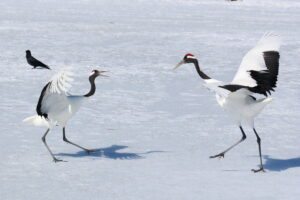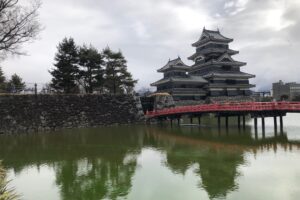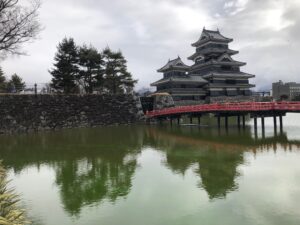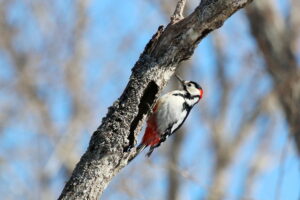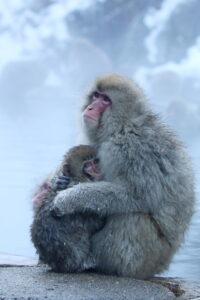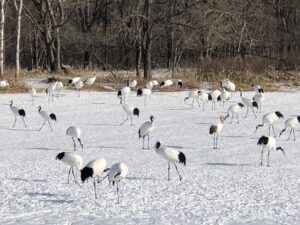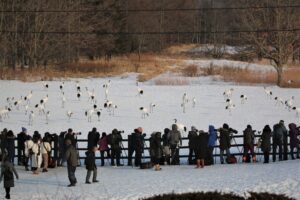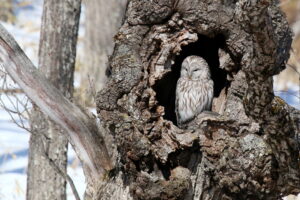Japan's Winter Birds & Culture
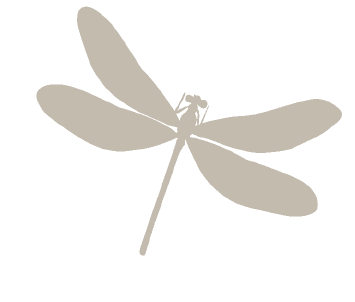
Cranes, Fish-Owls, Eagles, Castles, & More
December 2 - 15 2024
$6,400 | single supplement: $675
($500 deposit due upon registration)
12 participants max
W
inter in Japan is a fairytale of stunning birdlife, fascinating wildlife, dramatic landscapes, and magnificent culture. As the season's first snow falls on the Japanese Alps, we'll sit by a warm fire waiting for endangered Blakiston's Fish-Owls to arrive on their nightly hunting grounds. With a backdrop of farm fields and temples, we'll witness thousands of luminescent Hooded Cranes erupt from their morning roosts. We'll find Common Kingfishers hunting in the moat of 500-year old castles, and Mandarin Ducks paddling through mountain lakes. We'll watch Sea-Eagles fishing along the ocean, and meet Japanese Macaques (Japan's famous "snow monkeys") lounging in steamy hot springs. Immerse in Japan's most breathtaking destinations and iconic biodiversity.
Additional Information
Pacing, Physical Expectations, & Accommodations
Flow of the Day: The itinerary is designed to maximize our experience with Japan's great birdlife and landscapes. We won’t be rushing from place to place to chase the largest species list. Our goal instead is to spend time appreciating the species we encounter at an enjoyable pace. Birding walks often begin in the early morning, and we travel slowly to allow for the best bird and wildlife encounters and observation.
We visit several private reserves, gardens, and feeders where it is easier to find many of our target species. Afternoon plans typically involve traveling between towns and lodges. Our journey covers a lot of ground by van and by air, so please expect some half-day drives and occasional flights during this two-week adventure.
Clothing: We will provide a packing list as the trip approaches, but plan to pack for a range of weather conditions, including potential cold, snow, and rain. Temperatures in Hokkaido will likely be between 20 and 40 degrees F, whereas Izumi will likely be between 30 and high 50s. Our trip visits Japan before the coldest of winter conditions sets in, but travelers should be prepared with warm layers and rain/windproof outerwear. Good rain gear is essential, and a small umbrella is also recommended. Be sure to have a pair of comfortable walking shoes or hiking boots. You may want more casual clothing for traveling or dinners. A small washcloth and handkerchiefs will be helpful.
Equipment: Bring a pair of binoculars, a field guide and a camera with extra batteries. The guides will carry spotting scopes. Pack sunglasses and sunscreen, a small flashlight or headlamp, a small alarm clock (a smartphone will work), and a small daypack.
Health Considerations: Please consult your physician before the trip for any recommended immunizations or other medications. We will ask you to fill out a medical form prior to the trip, where we will ask you to disclose any medical issues that may impact your involvement on this trip.
Food and Drink: Water is safe to drink, and food is diverse and tasty. Our guide has decades of experience bringing American groups to Japan, and has selected restaurants that allow participants to sample local delicacies while also providing enough diversity to easily accommodate dietary restrictions and preferences.
Physical Expectations: Much of the birding on this trip will be along roadsides or on easily walked trails, but do expect some muddy, soggy, and snowy conditions from time to time. There is some birding at higher altitudes, which might require some folks to walk more slowly on hillier slopes.
Participants should be able to hike on moderate terrain up to 2-3 miles per day, and be ready to expect conditions that may be warm, cold, dry, wet, or anything in-between.
Transportation: In-country transportation is in a comfortable van.
Accommodations: All of the lodges where we’ll be staying are clean and comfortable with running water and electricity. They have been chosen to provide us the best access to the birdlife and birding destinations in Japan.
Your Guides
Chip Darmstadt is the NBNC Birding Ambassador and "emeritus" executive director for 27 years. Chip is an avid neotropical birder and naturalist. Chip has led birding trips in the US and across the world with NBNC for the last two decades, observing over 2,000 bird species along the way. Chip's first experience in the tropics was as a field assistant studying birds in Venezuela and Costa Rica. After catching the tropical birding bug, he has returned to the tropics many times to marvel at the incredible diversity of Central and South America. When not occupied with his varied NBNC duties, Chip works on extending his streak of over 1,500 consecutive days of eBird checklists!
Inclusions
What’s included:
- All lodging and meals while in Japan.
- All in-country airfare.
- Two expert naturalist guides.
- Any entrance fees and park admissions.
- Transportation in a comfortable van, including transfer to and from the airport.
- Pre-departure orientation session virtually or at North Branch Nature Center before the trip.
What is not included: International airfare, gratuities, incidentals, souvenirs, trip insurance, and alcohol.
Registration, Payments, and Cancellations
Ready to go to Japan?
Email Sean@NorthBranchNatureCenter.org to get signed up!
Payment Schedule
- A $500 deposit is required to reserve your space on the trip.
- 50% of the trip balance will be due 6 months before the departure date.
- Single travelers must include the single supplement fee with this payment. Single rooms are limited on this itinerary, so please confirm with us that your request for a single room can be accommodated before sending payment.
- The remaining trip balance will be due 3 months before the departure date.
All payments can be made via check to: North Branch Nature Center, 713 Elm Street, Montpelier, VT 05602
Cancellation Policies
We understand that incidents and emergencies arise that may force you to cancel your trip. However, NBNC invests considerable time and, in many cases, non-refundable payments to lodges and local contractors to secure our rooms and programming. NBNC aims to be as flexible as possible in our refund policy, but a full refund of your payments may not be possible after the dates indicated. All cancellations must be made via email to NBNC.
-
Cancellation more than 180 days before the trip: Full refund of all payments.
-
Cancellation 90-180 days before the trip: Refund of any payments minus the $500 deposit. If your space is filled by another traveler, we will also refund your deposit.
-
Cancellation 30-90 days before the trip: No refund guaranteed. If your space is filled by another traveler, we will provide a full refund minus the $500 deposit.
-
Cancellation less than 30 days before the trip: No refunds guaranteed.
Example Bird List
For a list of species seen in December in Japan, including frequency of encounter, Click Here.
Itinerary
(Itinerary subject to change based on weather, recent sightings, and guide and participant preferences)
Click each day below to expand
Day "0" - Flights from US (December 2)
Today we catch our international flights from New England to Japan. We'll cross the international date line and many time zones, putting us in Tokyo the evening of Day "1."
Day 1 - Arrival in Tokyo (Dec 3)
We will arrive in Tokyo this evening and overnight near Haneda Airport. We do not have any planned outings today, and folks can arrive anytime today. That said, our hotel is near the Kamo River, and if time allows, a 20-minute walk will bring us to an assortment of ducks and an interesting shrine.
We will meet for a group dinner to discuss the week ahead.
Day 2 - Tokyo to Nagano Birding
We will head out of Tokyo this morning, and travel about two hours into the countryside to arrive at the marshes where we will bird today. As we leave the city, the landscape becomes much more rural and agricultural. The vegetable and rice fields that we pass provide good wintering habitat for a variety of birds. Green Pheasant (the National Bird of Japan) is common here, although not always easy to see. A variety of buntings are also possible.
This is a great area for a variety of waterfowl - Whooper and Tundra Swan are both regular here, and we should be able to enjoy and compare both species side-by-side. Falcate Duck, Eurasian Wigeon, and Smew are also regular winter visitors to the area.
The birding today will be along along a paved walking path though a park bordering the marsh. Brown-eared Bulbuls, Japanese White-eye, Dusky Thrush, and Japanese Pygmy Woodpecker are usually around. With luck we may have a Daurian Redstart as well.
After spending the morning birding the marshes, we will continue our drive toward Nagano. Tokyo is on a huge flat plain known as the Kanto Plain. As we get closer to Nagano we will leave the flat plains and enter the beautiful mountains of Nagano. Nagano was the site for the 1998 winter Olympics and is full of ski resorts and other winter activities.
Overnight in Nagano
Day 3 - Hell's Canyon Snow Monkeys and Temples
This morning we will visit Jigokudani (Hell's Canyon) for the iconic Japanese Macaque - better know as the Snow Monkey. Living further north than any other monkey species, the Snow Monkeys have found interesting ways to deal with the cold. The monkeys at Jigokudani became world famous after discovering how nice a soak in a hot spring feels in the winter. It is about a mile walk to the Monkey Park, and we will arrive before the crowds so that we have a chance to see some birds along the hike.
Eurasian Jays and Japanese Woodpeckers are in the forest and mixed foraging flocks can hold Japanese, Coal, Willow, and Varied Tits.
After we finish with the Snow Monkeys, we will head back into Nagano and visit one of the most important Buddhist Temples in Japan - Zenkoji. The gardens here may have some interesting birds that we can search for while we walk around the amazing temples.
Overnight in Nagano
Day 4 - Matsumoto Castle
Today we have a 2 hour drive to Matsumoto. Our first stop will be a tour of Matsumoto Castle. The castle was built in the 1500's, and after a few restoration projects in the 1900's, is one of the premier castles in Japan today.
Before we tour the castle we will bird a bit around the gardens surrounding the castle. Tits, woodpeckers, and thrushes should be in the gardens, and the moat surrounding the castle holds a good variety of waterfowl in the winter. With luck we may even have a Common Kingfisher as well.
In the afternoon, we will visit a nearby park for birding with a great backdrop of the Japanese Alps. Birds here include Brambling, Long-tailed Rosefinch, several species of tits and woodpeckers.
Overnight in Matsumoto.
Day 5 Honshu to Hokkaido
Today we leave Honshu and travel to the Northern island of Hokkaido. Winter is intense here and bird numbers are low since most passerines go further south, but Hokkaido is home to some of the most iconic birds of our trip.
Our birding today will depend on flight times. We may have a bit of time to bird a local park before we leave Matsumoto, or perhaps some time to bird a bit when we arrive in Hokkaido. Our hotel tonight is in Tsurui village. Tsurui means "crane place" and has a large wintering population of Red-Crowned Cranes, one of the premier targets of our adventure.
Overnight in Tsurui
Day 6 - Cranes and Owls
This morning is all about cranes! We will visit a bridge where over a hundred cranes roost in the river and pose for great photography opportunities. If we are lucky, there is sometimes a Ural Owl roosting nearby.
As temperatures rise for the day, the cranes leave the river and go to a nearby sanctuary to feed for the day. Once the cranes leaves, we will turn our attention to the nearby trees for Marsh Tit (Hokkaido is the only place in Japan to see it) and the Hokkaido subspecies of Long-tailed Tit.
This afternoon we will drive on to our lodge where we will spend the next two nights. The hotel is a traditional "Onsen," a lodge built around a Hot Spring. It has multiple pools - indoor and out. There is a river just behind the lodge and large windows make for easy bird watching. Brown Dipper and Crested Kingfishers work the river, and Eurasian Jays, Great Spotted Woodpecker, and other birds visit the bird feeders.
The real excitement here starts at dark. A pair of Blakiston's Fish-Owls live nearby and visit the lodge every night. These trout-eating owls are the heaviest owl in the world, and among the largest and rarest. This lodge is one of only a few places on the planet where they can be reliably seen. We can view them as we sit by the warm fire, or if we are really lucky, we may see them while soaking in the hot springs!
Overnight Yoroushi Onsen
Day 7 - Coastal birding in Rausu
Today we will drive to coast. Islands claimed by Russia after WWII will be the back drop as we scan the ocean for Spectacled Guillemot and other alcids, plus a variety of sea ducks. We will make our way to Rausu - a small fishing village at the base of the Shiretoko Peninsula. Winter brings a large population of Steller's Sea-Eagles and White-tailed Eagles out of Kamchatka into northern Japan, and many spend the winter around Rausu.
If the conditions permit we will take a boat out of the harbor to photograph the eagles.
Tonight we are back at the Onsen again for another chance at the Fish Owl.
Overnight Yoroushi Onsen
Day 8 - Nemuro Peninsula
This morning we will work our way to the far eastern corner of Hokkaido to the Nemuro Peninsula. Along the way, we will make a few birding stops to scan the ocean. We will also pass Lake Furen, another spot that can be good for eagles. The Nemuro Peninsula has several hides (aka bird blinds) at key spots overlooking the ocean that can be very nice to get out of the cold weather.
There are a couple of parks with feeders here, and if the weather permits, we may do a short hike in the forest.
Overnight in Nemuro
Day 9 - Birding Kushiro
Today we will be birding our way back to Kushiro. We will decide our birding destinations based on what birds we have not yet observed. One good option is a rocky point called Kiritappu, possibly the best place in Hokkaido to look for Asian Rosy-Finches - a uncommon winter visitor.
We will have more chances for seabirds today, and if the weather is nice we will take a great walk with chances for Black Woodpecker and Hazel Grouse.
Overnight in Kushiro
Day 10 - Kurisho to Izumi
Today is primarily a travel day. We are leaving the cold and flying south to Kyushu where it should be pleasantly warm. Kyushu is located just southeast of the Korean Peninsula. Many birds migrate south through Korea and end up spending the winter in Kyushu. Birding is easy here, and the weather is normally nice compared to Hokkaido.
Overnight Izumi
Days 11 and 12 - Izumi Crane Spectacle
Our main birding area here is the Izumi Crane Observation Center - 10,000+ cranes winter here. About 70% are Hooded, and about 30% are White-naped, plus usually a couple Common, Sandhill, and even Siberian White or Demoiselle.
It is truly one of the most impressive birding spectacles in the world. We will get up early and watch the cranes as they leave their roosting ponds and fly into the nearby fields.
There are good numbers of other wintering species here as well, making this arguably the best single winter birding destination in Japan. We should find a variety of buntings here including Meadow, Masked, Chestnut-eared, and possibly Rustic. Reedbeds hold flocks of Common Reed Bunting, and with luck we may get a flock of Chinese Penduline-Tits as well.
We may visit a lake in the nearby mountains that often has wintering Mandarin Ducks, while Mountain Hawk-Eagles soar overhead.
A bit up the coast from Izumi is an area with huge mudflats that will be full of waterfowl, gulls, and shorebirds. Specifically, will target Saunder's Gull - a Southeast Asia specialty that winters here.
Overnight Izumi
Days 13 - Back to Tokyo, and International Departures (Dec 15)
Depending on today's flight schedule, we may have time to do a bit of morning birding near Kagoshima before we fly back to Tokyo.
We will arrive in Tokyo around noon, so people can book international flights for this evening (lots of flights leave Haneda about 4 or 5 PM) or some people may opt for a couple of days sight seeing in Tokyo. Given the complexities of our itinerary, we will advise participants on suggested arrival and departure flights and airports as the trip approaches.

713 Elm Street
Montpelier, Vermont 05602
(802) 229-6206
Hours: Center Open Monday-Friday 9-4
Trails Open 24/7

